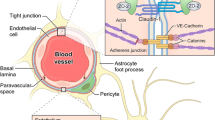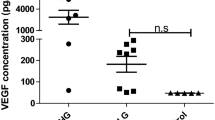Abstract
To identify a novel treatment modality for postoperative, glioma-related refractory cerebral edema (RCE), eight patients with postoperative RCE received chemotherapy between January 2008 and July 2012 were enrolled. There were five males and three females aged between 24 and 65 years (mean 45.7 years). Vascular endothelial growth factor (VEGF) levels in the cerebrospinal fluid were measured by enzyme-linked immuno-sorbent assay pre- and postchemotherapy. After 3 days postchemotherapy, midline shift improved from 13.14 ± 0.65 to 7.21 ± 0.55 mm and compressed or effaced basilar cisterns disappeared based on cranial computed tomographic scans. Glascow Coma Scale scores in patients significantly improved from 11.13 ± 0.52 to 14.50 ± 0.27 after chemotherapy. Two patients developed grade 1 leukopenia after 3 weeks, and one patient had grade 1 thrombocytopenia 2 weeks after chemotherapy. No fatal complications occurred. The edematous volume reduced from 77,074 ± 6,813 to 27,874 ± 5,073 mm3 (p < 0.001). VEGF levels were significantly downregulated after chemotherapy (from 543.8 ± 76.39 to 122.2 ± 59.30 pg/ml, p < 0.001). Chemotherapy may serve to alleviate glioma-related RCE by reducing VEGF levels, especially in patients who were insensitive to decompressive craniectomy.




Similar content being viewed by others
References
Kaal EC, Vecht CJ. The management of brain edema in brain tumors. Curr Opin Oncol. 2004;16(6):593–600.
Stummer W. Mechanisms of tumor-related brain edema. Neurosurg Focus. 2007;22(5):E8.
Liebner S, Fischmann A, Rascher G, Duffner F, Grote EH, Kalbacher H, et al. Claudin-1 and claudin-5 expression and tight junction morphology are altered in blood vessels of human glioblastoma multiforme. Acta Neuropathol. 2000;100(3):323–31.
Papadopoulos MC, Saadoun S, Woodrow CJ, Davies DC, Costa-Martins P, Moss RF, et al. Occludin expression in microvessels of neoplastic and non-neoplastic human brain. Neuropathol Appl Neurobiol. 2001;27(5):384–95.
Berkman RA, Merrill MJ, Reinhold WC, Monacci WT, Saxena A, Clark WC, et al. Expression of the vascular permeability factor/vascular endothelial growth factor gene in central nervous system neoplasms. J Clin Invest. 1993;91(1):153–9.
Pietsch T, Valter MM, Wolf HK, von Deimling A, Huang HJ, Cavenee WK, et al. Expression and distribution of vascular endothelial growth factor protein in human brain tumors. Acta Neuropathol. 1997;93(2):109–17.
Nishikawa R, Cheng SY, Nagashima R, Huang HJ, Cavenee WK, Matsutani M. Expression of vascular endothelial growth factor in human brain tumors. Acta Neuropathol. 1998;96(5):453–62.
Plate KH, Breier G, Weich HA, Mennel HD, Risau W. Vascular endothelial growth factor and glioma angiogenesis: coordinate induction of VEGF receptors, distribution of VEGF protein and possible in vivo regulatory mechanisms. Int J Cancer. 1994;59(4):520–9.
Bates DO, Lodwick D, Williams B. Vascular endothelial growth factor and microvascular permeability. Microcirculation. 1999;6(2):83–96.
Shibata T, Giaccia AJ, Brown JM. Development of a hypoxia-responsive vector for tumor-specific gene therapy. Gene Ther. 2000;7(6):493–8.
Wick W, Kuker W. Brain edema in neurooncology: radiological assessment and management. Onkologie. 2004;27(3):261–6.
Williams BJ, Park DM, Sheehan JP. Bevacizumab used for the treatment of severe, refractory perilesional edema due to an arteriovenous malformation treated with stereotactic radiosurgery. J Neurosurg. 2012;116(5):972–7.
van der Meer C, van Lindert E, Petru R. Late decompressive craniectomy as rescue treatment for refractory high intracranial pressure in children and adults. Acta Neurochir Suppl. 2012;114:305–10.
Maas AI, Hukkelhoven CW, Marshall LF, Steyerberg EW. Prediction of outcome in traumatic brain injury with computed tomographic characteristics: a comparison between the computed tomographic classification and combinations of computed tomographic predictors. Neurosurgery. 2005;57(6):1173–82.
Mou K, Chen M, Mao Q, Wang P, Ni R, Xia X, et al. AQP-4 in peritumoral edematous tissue is correlated with the degree of glioma and with expression of VEGF and HIF-alpha. J Neurooncol. 2010;100(3):375–83.
Papadopoulos MC, Saadoun S, Binder DK, Manley GT, Krishna S, Verkman AS. Molecular mechanisms of brain tumor edema. Neuroscience. 2004;129(4):1011–20.
van den Bent MJ, Hegi ME, Stupp R. Recent developments in the use of chemotherapy in brain tumours. Eur J Cancer. 2006;42(5):582–8.
Perry JR, Belanger K, Mason WP, Fulton D, Kavan P, Easaw J, et al. Phase II trial of continuous dose-intense temozolomide in recurrent malignant glioma: RESCUE study. J Clin Oncol. 2010;28(12):2051–7.
Buie LW, Valgus J. Bevacizumab: a treatment option for recurrent glioblastoma multiforme. Ann Pharmacother. 2008;42(10):1486–90.
Choi IS, Lee SH, Kim TY, Bang JS, Paek SH, Kim S, et al. Phase II study of chemotherapy with ACNU plus cisplatin followed by cranial irradiation in patients with newly diagnosed glioblastoma multiforme. J Neurooncol. 2002;60(2):171–6.
Grossman SA, O’Neill A, Grunnet M, Mehta M, Pearlman JL, Wagner H, et al. Phase III study comparing three cycles of infusional carmustine and cisplatin followed by radiation therapy with radiation therapy and concurrent carmustine in patients with newly diagnosed supratentorial glioblastoma multiforme: Eastern Cooperative Oncology Group Trial 2394. J Clin Oncol. 2003;21(8):1485–91.
Park CK, Park SH, Lee SH, Kim CY, Kim DW, Paek SH, et al. Methylation status of the MGMT gene promoter fails to predict the clinical outcome of glioblastoma patients treated with ACNU plus cisplatin. Neuropathology. 2009;29(4):443–9.
Cartmill M, Hewitt M, Walker D, Lowe J, Jaspan T, Punt J. The use of chemotherapy to facilitate surgical resection in pleomorphic xanthoastrocytoma: experience in a single case. Childs Nerv Syst. 2001;17(9):563–6.
Valera ET, Serafini LN, Machado HR, Tone LG. Complete surgical resection in children with low-grade astrocytomas after neoadjuvant chemotherapy. Childs Nerv Syst. 2003;19(2):86–90.
Valera ET, Machado HR, Santos AC, de Oliveira RS, Araujo D, Neder L, et al. The use of neoadjuvant chemotherapy to achieve complete surgical resection in recurring supratentorial anaplastic ependymoma. Childs Nerv Syst. 2005;21(3):230–3.
Voloschin AD, Louis DN, Cosgrove GR, Batchelor TT. Neoadjuvant temozolomide followed by complete resection of a 1p- and 19q-deleted anaplastic oligoastrocytoma: case study. Neuro Oncol. 2005;7(1):97–100.
Acknowledgments
Beijing Natural Science Foundation (7122061) financially supported this work.
Conflict of interest
The authors declare that there are no conflicts of interest in this study. No external funding, apart from the support of the authors’ institution, was available for this study.
Author information
Authors and Affiliations
Corresponding author
Rights and permissions
About this article
Cite this article
Li, Hl., Cui, Xl., Zhang, Jn. et al. Chemotherapy alleviates subacute recurrent glioma-associated refractory cerebral edema by downregulating vascular endothelial growth factor. Med Oncol 31, 13 (2014). https://doi.org/10.1007/s12032-014-0013-9
Received:
Accepted:
Published:
DOI: https://doi.org/10.1007/s12032-014-0013-9




